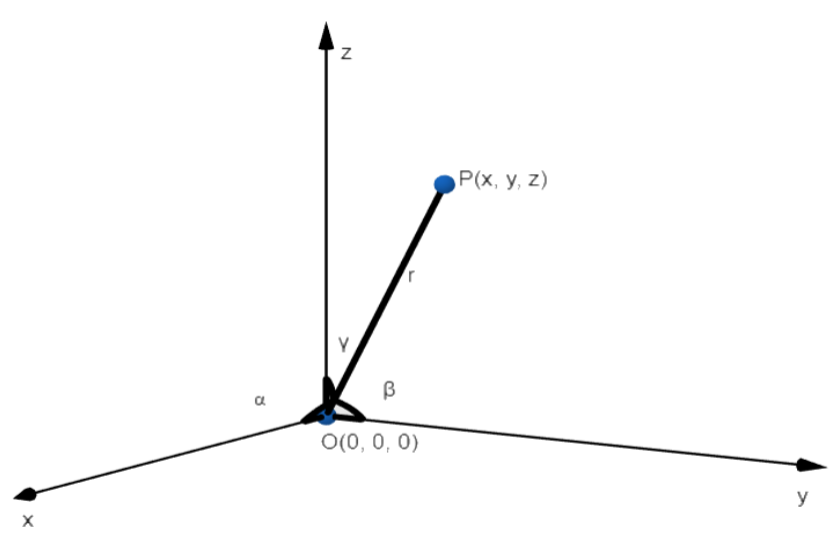
If OP = r, d.c’s of \[\overrightarrow{OP}\] are l, m and n then $P=(lr,mr,nr)$.
Answer
568.8k+ views
Hint: To solve this question, we will first write the values of direction cosines in the Cartesian form. After that, we will find the length of line OP which passes through point P ( x, y z ) and origin. After that, we will substitute the value of length OP = r in values of direction cosines and hence obtain the coordinates of P in terms of cosines of line OP.
Complete step-by-step solution
Before we solve this question, let us see what direction cosines are.
In three – dimension geometry, we have three axes which are the x-axis, y-axis, and z-axis. Now, let us assume that line OP passes through the origin in the three – dimensional space. Then, it is obvious that the line will make an angle each with the x-axis, y-axis, and z-axis respectively.
Now, cosines of each of these three angles that the line makes with the x-axis, y-axis, and z-axis respectively are called direction cosines of the line in three-dimensional space. In general, these direction cosines are denoted by using letters l, m, and n.

Now, we know that if l, m and n are direction cosines of a line passing through origin to point P(x, y, z), then $l=\dfrac{x}{\sqrt{{{x}^{2}}+{{y}^{2}}+{{z}^{2}}}}$ , $m=\dfrac{y}{\sqrt{{{x}^{2}}+{{y}^{2}}+{{z}^{2}}}}$, $n=\dfrac{z}{\sqrt{{{x}^{2}}+{{y}^{2}}+{{z}^{2}}}}$
Now as OP passes from O( 0, 0, 0 ) and P( x, y, z )
So, using distance formula
$OP=\sqrt{{{(x-0)}^{2}}+{{(y-0)}^{2}}+{{(z-0)}^{2}}}$
On simplifying, we get
$OP=\sqrt{{{x}^{2}}+{{y}^{2}}+{{z}^{2}}}$
As, given that OP = r
So, $r=\sqrt{{{x}^{2}}+{{y}^{2}}+{{z}^{2}}}$
Substituting value of $r=\sqrt{{{x}^{2}}+{{y}^{2}}+{{z}^{2}}}$ in values of direction cosines, we get
$l=\dfrac{x}{r}$ , $m=\dfrac{y}{r}$, $n=\dfrac{z}{r}$
Multiplying, both sides by r, we get
x = lr, y = mr and z = nr
Now, as (x, y, z ) are the coordinates of point P.
So, P ( lr, mr, nr )
Note: Always remember that if line passes through origin and point P ( x, y, z ) then direction cosines of line OP are equals to $l=\dfrac{x}{\sqrt{{{x}^{2}}+{{y}^{2}}+{{z}^{2}}}}$ , $m=\dfrac{y}{\sqrt{{{x}^{2}}+{{y}^{2}}+{{z}^{2}}}}$, $n=\dfrac{z}{\sqrt{{{x}^{2}}+{{y}^{2}}+{{z}^{2}}}}$. Also remember that length of line passing through points L( a, b, c ) and M( x, y, z ) is equals to $LM=\sqrt{{{(x-a)}^{2}}+{{(y-b)}^{2}}+{{(z-c)}^{2}}}$. Try not to make any error while solving the question.
Complete step-by-step solution
Before we solve this question, let us see what direction cosines are.
In three – dimension geometry, we have three axes which are the x-axis, y-axis, and z-axis. Now, let us assume that line OP passes through the origin in the three – dimensional space. Then, it is obvious that the line will make an angle each with the x-axis, y-axis, and z-axis respectively.
Now, cosines of each of these three angles that the line makes with the x-axis, y-axis, and z-axis respectively are called direction cosines of the line in three-dimensional space. In general, these direction cosines are denoted by using letters l, m, and n.

Now, we know that if l, m and n are direction cosines of a line passing through origin to point P(x, y, z), then $l=\dfrac{x}{\sqrt{{{x}^{2}}+{{y}^{2}}+{{z}^{2}}}}$ , $m=\dfrac{y}{\sqrt{{{x}^{2}}+{{y}^{2}}+{{z}^{2}}}}$, $n=\dfrac{z}{\sqrt{{{x}^{2}}+{{y}^{2}}+{{z}^{2}}}}$
Now as OP passes from O( 0, 0, 0 ) and P( x, y, z )
So, using distance formula
$OP=\sqrt{{{(x-0)}^{2}}+{{(y-0)}^{2}}+{{(z-0)}^{2}}}$
On simplifying, we get
$OP=\sqrt{{{x}^{2}}+{{y}^{2}}+{{z}^{2}}}$
As, given that OP = r
So, $r=\sqrt{{{x}^{2}}+{{y}^{2}}+{{z}^{2}}}$
Substituting value of $r=\sqrt{{{x}^{2}}+{{y}^{2}}+{{z}^{2}}}$ in values of direction cosines, we get
$l=\dfrac{x}{r}$ , $m=\dfrac{y}{r}$, $n=\dfrac{z}{r}$
Multiplying, both sides by r, we get
x = lr, y = mr and z = nr
Now, as (x, y, z ) are the coordinates of point P.
So, P ( lr, mr, nr )
Note: Always remember that if line passes through origin and point P ( x, y, z ) then direction cosines of line OP are equals to $l=\dfrac{x}{\sqrt{{{x}^{2}}+{{y}^{2}}+{{z}^{2}}}}$ , $m=\dfrac{y}{\sqrt{{{x}^{2}}+{{y}^{2}}+{{z}^{2}}}}$, $n=\dfrac{z}{\sqrt{{{x}^{2}}+{{y}^{2}}+{{z}^{2}}}}$. Also remember that length of line passing through points L( a, b, c ) and M( x, y, z ) is equals to $LM=\sqrt{{{(x-a)}^{2}}+{{(y-b)}^{2}}+{{(z-c)}^{2}}}$. Try not to make any error while solving the question.
Recently Updated Pages
A man running at a speed 5 ms is viewed in the side class 12 physics CBSE

The number of solutions in x in 02pi for which sqrt class 12 maths CBSE

State and explain Hardy Weinbergs Principle class 12 biology CBSE

Write any two methods of preparation of phenol Give class 12 chemistry CBSE

Which of the following statements is wrong a Amnion class 12 biology CBSE

Differentiate between action potential and resting class 12 biology CBSE

Trending doubts
What are the major means of transport Explain each class 12 social science CBSE

Which are the Top 10 Largest Countries of the World?

Draw a labelled sketch of the human eye class 12 physics CBSE

Explain sex determination in humans with line diag class 12 biology CBSE

Explain sex determination in humans with the help of class 12 biology CBSE

Differentiate between homogeneous and heterogeneous class 12 chemistry CBSE




